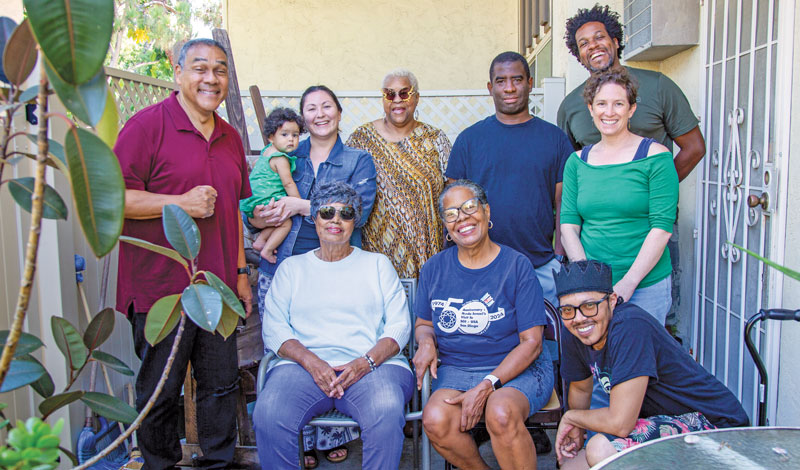Please base your monthly discussion meeting study on one of the following:
1) Buddhist Concepts (pp. 44–45)
2) Writings for Discussion Meetings (pp. 46–47)
3) Material from any recent issue of the World Tribune or Living Buddhism
Buddhist Concepts
What Does Soka Mean?
This November 18 marks the 95th anniversary of the Soka Gakkai’s founding—a perfect opportunity to reflect on and reaffirm the profound spirit embodied in the word soka.
This term originated in February 1930, during a late-night conversation between Josei Toda and his mentor, Tsunesaburo Makiguchi, about publishing a book on Mr. Makiguchi’s theory of education. Ikeda Sensei recounts their exchange in The New Human Revolution:
“What’s the aim of your educational theory?” asked Mr. Toda.
“In a word, to create value,” answered Mr. Makiguchi.
His cheeks flushed with excitement, Mr. Toda said: “Sensei, how about calling it ‘value-creating education’?”
“Yes, that’s a good name!”[1]
From this dialogue between mentor and disciple, the ideal of Soka was born. Their discussion led to the publication of Soka kyoikugaku taikei (The System of Value-Creating Pedagogy) on November 18, 1930—now celebrated as the Soka Gakkai’s founding day.
Today, the Soka Gakkai has become a global Buddhist movement dedicated to helping all people create happiness, success and peace in their lives and communities.
A History of Changing Poison into Medicine
How do we deal with difficulties? By facing them head-on with faith. At the heart of our Buddhist practice lies the idea of creating value through the Buddhist principle of “changing poison into medicine.”
Ikeda Sensei explains that value creation means “finding the deeper significance of everything that happens in our lives, deriving gratitude and joy from it, strengthening our spirit and creating happiness.”[2]
Throughout its history, the Soka Gakkai has embodied this principle.
One key moment is July 3, 1945, when Mr. Toda was released from prison after two years of confinement for refusing to accept the state religion of Shinto. In January 1945, while still incarcerated, he learned that his mentor had passed away on November 18, 1944, in the prison infirmary.
Emerging from prison, Mr. Toda vowed to avenge his mentor by achieving his dream of kosen-rufu and creating a society of lasting peace.[3] Though filled with anger at the unjust authorities, he transformed it into a powerful determination, launching a renewed effort to spread Nichiren Buddhism. His disciple Daisaku Ikeda carried that struggle forward, leading the expansion of the movement to more than 10 million practitioners in Japan and millions more around the world.
Another pivotal moment came on November 28, 1991, when the Nichiren Shoshu priesthood excommunicated millions of Soka Gakkai members. Despite repeated efforts to resolve conflicts, the priesthood chose authoritarian control over dialogue.
For many lay religious groups, such a break might have meant collapse. For the Soka Gakkai, however, it became a catalyst for spiritual independence and fresh growth, freeing the movement to flourish globally as a lay organization practicing in accord with Nichiren’s spirit and teachings.[4]
Move Forward, Creating Value Every Day
How can we create value in our own lives?
Our daily Buddhist practice is grounded in three key elements: faith, practice and study.
We develop faith through doing gongyo and chanting Nam-myoho-renge-kyo to the Gohonzon morning and evening, tapping our Buddha nature and approaching everything with an elevated state of life.
We study Nichiren’s writings and Sensei’s guidance, gaining insights and wisdom to overcome obstacles and achieve our goals.
And our Buddhist practice entails encouraging and supporting those around us, working together to expand our lives while contributing to the betterment of our surroundings.
Sensei reminds us:
Difficulties are inevitable. The important thing is how we transform them, changing poison into medicine, and use them as the driving force for fresh growth and progress.
There is no point in feeling anxious or lamenting each time the harsh winds of adversity blow. If we have a powerful determination to change everything that happens into a strong “tailwind,” we can surely open the way forward.[5]
As long as we maintain a Buddhist practice that flows like a river, we can transform any situation and create enduring value from every experience.
Writings for Discussion Meetings
Benefit in Buddhism
Passage
The element ku in the word kudoku means good fortune or happiness. It also refers to the merit achieved by wiping out evil, while the element toku or doku refers to the virtue one acquires by bringing about good. Thus the word kudoku means to attain Buddhahood in one’s present form. —The Record of the Orally Transmitted Teachings, p. 148
Background
When thinking of getting benefits through our Buddhist practice, some might initially think of material and external gains, like getting a new job or improving a difficult relationship. As expressed in the passage above, there’s another aspect of benefit in Nichiren Buddhism: “wiping out evil” and “bringing about good.”
In essence, Nichiren Daishonin teaches that unless we overcome the negative, destructive tendencies within us, we cannot reveal our enlightened nature.
This passage comes from Nichiren’s commentary on the Lotus Sutra’s 19th chapter, “Benefits of the Teacher of the Law.” In this chapter, Shakyamuni describes the benefits gained when one carries out the five kinds of practice—embracing, reading, reciting, expounding and transcribing the Lotus Sutra.
Nichiren explains that chanting Nam-myoho-renge-kyo encompasses these five practices.[6] And he says above that the reward or benefit (kudoku) of “wiping out evil” is attaining Buddhahood, also described as purifying our lives. Through chanting, we can elevate our life condition, free ourselves from delusion and suffering, and fully exercise the power of the Buddha nature within our lives as we take action for our own and others’ happiness.
—Prepared by the SGI-USA Study Department
Ikeda Sensei’s Encouragement
Eliminating Evil to Reveal Our Inherent Goodness
This is a passage I have engraved in my heart from the days of my youth. It tells us that benefit means eliminating the impurities or delusion in our own lives and bringing out our inherent purity and goodness.
Kosen-rufu is an eternal struggle between the Buddha and devilish functions.
[Second Soka Gakkai President Josei] Toda often said: “Faith is a struggle against deadlock—for the individual and for humanity. It is a struggle between the Buddha nature and devilish functions. That is the meaning of ‘Buddhism concerns itself with winning.’” That is precisely why we must not allow good to be defeated by evil. It must triumph. Buddhism teaches that the Buddha and devilish functions are engaged in a fierce and ceaseless struggle in the depths of our lives.
The goodness inherent in life is the fundamental nature of enlightenment, or Dharma nature. In contrast, the evil or devilish nature inherent in life is fundamental darkness or ignorance. …
When we have faith in the Buddha nature within us and chant Nam-myoho-renge-kyo, our fundamental nature of enlightenment is activated and the positive, protective functions of the universe are manifested.
At the same time, in the Latter Day of the Law, when right and wrong are confused and turned upside-down, fundamental darkness is amplified through contact with innumerable negative influences rampant in society. This intensifies the onslaughts of devilish forces against the practitioners of the Lotus Sutra.
And that is precisely why we need to fight against and triumph over external evils in the world. The battle against external evils is one and the same as the conquest of inner evil and the manifestation of inner goodness.
Through our struggle against devilish functions, we forge, strengthen and purify our lives. Eliminating evil and bringing forth good are the two components of benefit. Fighting against evil functions is the way to accumulate benefit and attain Buddhahood. (The Five Eternal Guidelines of the Soka Gakkai, pp. 77–79)
From the November Living Buddhism
References
- The New Human Revolution, vol. 23, p. 258. ↩︎
- NHR-28, 34–35. ↩︎
- See NHR-2, revised edition, 242. ↩︎
- The Soka Gakkai has expanded from 115 countries and territories in 1991 to 192 today. ↩︎
- The Wisdom for Creating Happiness and Peace, part 1, revised edition, p. 183. ↩︎
- See “The Real Aspect of the Gohonzon,” The Writings of Nichiren Daishonin, vol. 1, p. 833. ↩︎
You are reading {{ meterCount }} of {{ meterMax }} free premium articles

